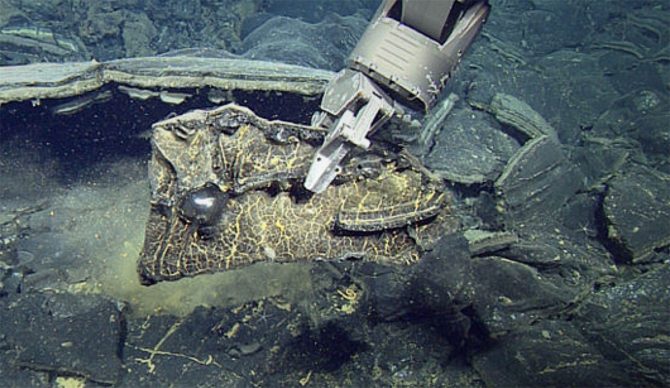
Collecting a fragment of lava from the 2015 eruption of Axial Seamount. Photo: MBARI
An underwater volcano off the coast of Oregon could be on the verge of eruption. Researchers studying it have done something they wouldn’t normally do: predict that it will erupt before 2025 is wrapped up.
It’s nearly impossible to accurately forecast a volcano’s eruption, at least more than a few hours out. Predicting those blowups could be super helpful, of course, so scientists are always on the lookout for ways to practice. The Axial Seamount gives them a perfect opportunity.
The Axial Seamount in one of the most active oceanic volcanos in its area. Sitting about 300 miles off the North American west coast, it erupts on a pretty regular basis. That gives scientists plenty of data to see what it does in the days, weeks, and months leading up.
In the mid 1990s, it became the first underwater volcano observatory for precisely that reason. Researchers have been studiously poring over data captured by recording equipment, and it’s proving to be helpful.
“The key finding so far has been related to a characteristic inflation of Axial’s surface in the months prior to an eruption, as magma accumulates underground and pressure starts to build,” writes IFLScience. “This is typically accompanied by a massive increase in seismic activity, with hundreds of quakes detected each day.”
One large eruption in 2015 is particularly useful. Part of the data that could indicate an imminent eruption is the swelling of the sea floor around the volcano.
“Attempts at forecasting the timing of the next eruption at Axial since 2015 by simply extrapolating the most recent average rate of inflation have been completely unsuccessful because of the steadily decreasing rate between 2015-2023,” the scientists wrote in a paper detailing their findings. “However, now that the rate of inflation is suddenly increasing again, and because the cumulative uplift is so close to the threshold reached before the last eruption in 2015, it now seems a better time to attempt to forecast the next eruption again. Based on the current trends, and the assumption that Axial will be primed to erupt when it reaches the 2015 inflation threshold, our current eruption forecast window is between now (July 2024) and the end of 2025. If the rate of inflation and seismicity continue to increase, an eruption may be likely before the end of 2024.”
While there are only a few days left in 2024, it does indeed seem likely that the scientists’ forecast of 2025 will come to fruition.
“Geologists know that Axial Volcano erupted in 1998, 2011, and 2015, and dozens of times in the preceding 350 years,” wrote scientists at the Monterey Bay Aquarium Research Institute. “Thus it is likely that the next eruption will occur some time within the next decade. When that happens, MBARI’s newly created bathymetric map will provide essential information for geologists trying to figure out the extent and volume of the latest flow from this amazingly active underwater volcano.”

